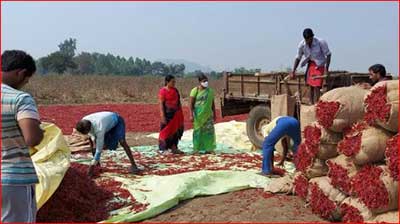Date: 21/04/2023
Relevance: GS-3: Major crop-cropping patterns in various parts of the country, different types of irrigation and irrigation systems storage.
Key Phrases: Minimum Support Price, Commission for Agricultural Costs and Prices, Diversification of crops, Farmer Producer Organization, Fiscal burden.
Context:
- India, being predominantly an agrarian economy, faces several challenges in the agriculture sector due to fragmented landholdings, rain-fed agriculture, climate change, low disbursement of institutional credit, high cost of cultivation, and exploitation by intermediaries.
- The Minimum Support Price (MSP) model has resulted in skewed cropping patterns and adverse environmental impacts.
About MSP:
- The Minimum Support Price (MSP) is a policy implemented by the Indian government to ensure that farmers get a fair price for their crops.
- The government sets a floor price for various crops, and if market prices fall below this level, the government promises to purchase the crops at the MSP.
- These are announced by the Government of India at the beginning of the sowing season for certain crops on the basis of the recommendations of the Commission for Agricultural Costs and Prices (CACP).
- MSP is price fixed by Government of India to protect the producer - farmers - against excessive fall in price during bumper production years.
- The minimum support prices are a guarantee price for their produce from the Government.
- As of now, CACP recommends MSPs of 23 commodities, which comprise 7 cereals (paddy, wheat, maize, sorghum, pearl millet, barley and ragi), 5 pulses (gram, tur, moong, urad, lentil), 7 oilseeds (groundnut, rapeseed-mustard, soyabean, seasmum, sunflower, safflower, nigerseed), and 4 commercial crops (copra, sugarcane, cotton and raw jute).
However, the MSP model has several adverse implications:
- Distorts markets:
- The MSP model distorts markets by creating an artificial floor price for crops.
- This can lead to overproduction of certain crops, which can then cause a glut in the market and depress prices.
- Skews cropping patterns:
- Farmers tend to focus on growing crops that are covered under the MSP scheme, leading to an imbalanced cropping pattern that can affect soil health and water resources.
- Encourages water-intensive crops:
- Since crops like paddy and sugarcane are covered under the MSP scheme, farmers tend to grow these crops even in areas with water scarcity.
- This leads to a depletion of groundwater resources.
- Fiscal burden:
- The government has to bear the cost of purchasing crops at the MSP, which can create a significant fiscal burden.
To address these issues, the following policy initiatives are proposed:
- Input credit to farmers:
- Providing input subsidies to farmers on seeds, pesticides, and fertilizers can help phase out the MSP model gradually. Additionally, labour from MGNREGS can be provided to small and marginal farmers to reduce their cultivation costs.
- Before phasing out MSP, strengthening the Farmer Producer Organization (FPO) model by forming federations to achieve collective bargaining power and economies of scale should be prioritized.
- Convergence of SHGs and FPOs:
- The self-help group model can be used to converge with FPOs to establish a pan-India FPO network.
- Mango orchards and other crops can be managed by farmers, and SHG women can process them for value-added products.
- Diversification of crops:
- Diversifying to crops like millets, pulses, oilseeds, and spices can reduce the dependence on imports while promoting nutritional and financial security.
- FPOs can be trained in commodity derivatives to market their produce.
- Focus on exports:
- Encouraging Indian farmers to grow commercial crops for exports can improve remunerative prices.
- Agricultural value chains can be established through the 'One District One Product' model.
- Access to institutional credit:
- Improving access to low-cost institutional credit for small and marginal farmers is critical.
- The current average loan size of ₹43.85 lakh is inadequate for FPOs with more than 750 members.
- Seamless market linkages:
- Crafting a marketing strategy by procuring agri-produce at farm-gate in all districts through the public-private partnership model can benefit FPOs, which already supply to e-commerce retailers directly or through agri startups.

One District One Product:
- The scheme adopts the One District One Product (ODOP) approach to reap the benefit of scale in terms of procurement of inputs, availing common services and marketing of products.
- ODOP for the scheme will provide the framework for value chain development and alignment of support infrastructure.
- There may be more than one cluster of ODOP products in one district.
- There may be a cluster of ODOP products consisting of more than one adjacent district in a State.
Conclusion:
- Agriculture in India faces various challenges, including fragmented landholdings, climate change, and high costs.
- However, policy initiatives such as input credit, SHGs, and FPOs, diversification of crops, and focus on exports can improve the viability of agriculture in India.
- Moreover, incentivising the cultivation of millets, pulses, oilseeds, and spices can reduce dependence on imports and promote food security.
- Additionally, commercial crops for exports and the 'One District One Product' model can develop agricultural value chains.
Source: The Hindu BL
Mains Question:
Q. What are the major challenges faced by agriculture sector in India? Discuss the policy initiatives to address these challenges. (250 Words).






















